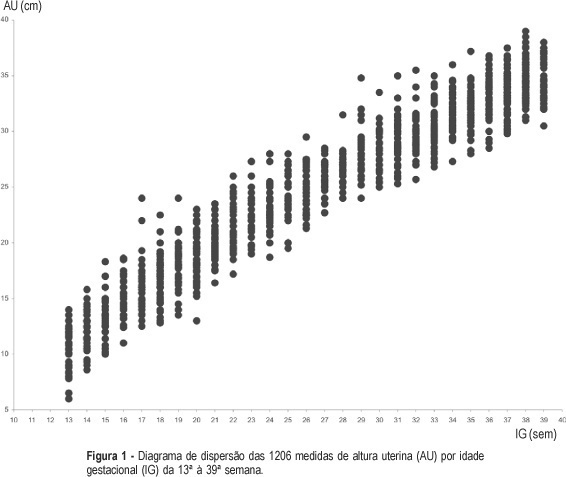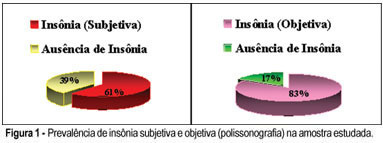Summary
Revista Brasileira de Ginecologia e Obstetrícia. 2006;28(1):3-9
DOI 10.1590/S0100-72032006000100002
PURPOSE: to build a curve of fundal height according to gestational age among low-risk pregnant women and to compare it with the official standards used in Brazil. METHODS: a prospective observational study was carried out. A sample of 227 low-risk pregnant women with gestational age from 13 to 39 weeks was followed-up in the prenatal care sector of two public health services from João Pessoa, PB. Women with a known gestational age, a single live fetus, without malformation, with no known maternal-fetal pathological condition that could possibly affect fetal growth, with a normal body weight, and non-smokers were included in the study. Their fundal height was measured in a standard way, after a previous ultrasound done to confirm the gestational age. The same investigator performed 1206 measurements and each woman had a mean of 5.3 measurements. Statistical tests were performed with a significance level of 5%. Tables and graphs of fundal height were built according to the gestational age with the 10th, 50th and 90th percentiles. RESULTS: the values of percentiles 10, 50 and 90 of fundal height in each gestational age allowed the construction of a pattern curve of fundal height by gestational age among low-risk pregnant women. A clear visual difference was observed between this new and the official fundal height curve. Statistical analyses showed significant differences between them from the 19th week on. CONCLUSION: the results suggest different normal fundal height and fetal growth patterns among low-risk pregnant women on prenatal assistance compared to the used standard curve, thus with different performances when used for diagnosing fetal growth deviations. Future studies should validate the current fundal height curve by gestational age in order to possibly use it as a reference pattern.

Summary
Revista Brasileira de Ginecologia e Obstetrícia. 2006;28(1):24-31
DOI 10.1590/S0100-72032006000100005
PURPOSE: to verify the coverage and factors associated with Papanicolaou (Pap) testing in Londrina (PR), Brazil. METHODS: this is a cross-sectional study, carried out in 2004, in microareas of five Basic Health Units (BHU) of Londrina. One or two microareas from each BHU were selected and a list of all women aged 20-59 years resident in these places, was made through search in the Basic Attention Information System, the women being then visited and interviewed. Those with a Pap test in the last three years were considered as having an updated examination, and the remaining as delayed. The association of some factors with the examination situation was investigated. Data analysis was performed using Epi-Info 6.04d. RESULTS: Pap smear coverage among the 513 participants of the study was 80.7%, ranging from 71.5% to 88.4%. Delay in taking the test was higher (p<0.05) among women who worked only at home (22.4% as compared with 14.3% among those who worked outside), and among those who belonged to D/E social classes (24.9%) as compared to C (17.5%) and A/B (8.3%) classes. The proportion who ignored the next test date was higher (p<0.01) among those who had the last Papanicolaou testing at a BHU (14.7%), as compared to those who had been attended privately or by a health insurance company (5.8%). CONCLUSION: the coverage of Pap smear in the studied areas can be considered satisfactory, although there is a need of improving compliance with Pap test, mainly among women who are the poorest and who work only at home.
Summary
Revista Brasileira de Ginecologia e Obstetrícia. 2006;28(1):18-23
DOI 10.1590/S0100-72032006000100004
PURPOSE: to characterize postmenopausal endometrial polyps and to determine risk for concomitant premalignant and malignant pathology. METHODS: a retrospective study including 82 postmenopausal women with a histological diagnosis of endometrial polyps who underwent hysteroscopic polypectomy, after a diagnosis of endometrial thickening made by transvaginal ultrasound, was performed. Medical reports provided clinical and gynecological history, data related to the operative hysteroscopy and definitive histological findings. RESULTS: among the 82 patients who underwent hysteroscopic polypectomy, 10.9% were receiving some type of hormonal therapy. Twenty-eight women (34.1%) reported abnormal vaginal bleeding. Single polyp was encountered in 56 women (68.3%), two polyps were found in 19 cases (23.2%) and in 7 cases (3.6%), three or more polyps were found. The definitive histopathologic analysis revealed 63 (76.8%) benign polyps, 17 (20.8%) hyperplastic polyps (10 cases 12.2% - of simple endometrial hyperplasia without cytologic atypia and 7 cases 8.6% - of complex endometrial hyperplasia without cytologic atypia). Two polyps (2.4%) were diagnosed as harboring neoplasia. For the statistical analysis we employed chi2 test improved by Yates. The authors correlated the polyps' histology with the occurrence of abnormal vaginal bleeding (p=0.0056), number of endometrial polyps (p=0.921) and time after menopause (p=0.720). CONCLUSIONS: endometrial polyps are commonly found entities in postmenopausal women, related with low frequency to endometrial hyperplasia or carcinomas and only histological evaluation seems to allow the exclusion of premalignant and malignant pathology.
Summary
Revista Brasileira de Ginecologia e Obstetrícia. 2006;28(1):10-17
DOI 10.1590/S0100-72032006000100003
PURPOSE: to describe to emotional process experienced with termination of pregnancy after the diagnosis of lethal fetal malformation. METHODS: thirty-five pregnant women who underwent termination of pregnancy for lethal fetal anomaly after judicial permission were interviewed. The most frequent fetal malformation was anencephaly (71.5%). The patients were submitted to an open interview as soon as the diagnosis of fetal malformation was confirmed, allowing them to express their feelings and stimulating them to think about asking for termination of pregnancy. The mean time spent until the judicial agreement was 16.6 days. The women who requested and were submitted to the procedure of abortion were invited to return for psychological evaluation after 30-60 days. At this moment, a semi-structured interview was performed to find the emotional aspects and feelings that existed. RESULTS: thirty-five patients were interviewed. The decision-making feelings about termination of pregnancy were negative for 60%, 51.4% declared that they had no doubts about the assumed decision and 65.7% declared that their own opinion was more important for decision than anyone else's. Most of the women (89%) affirmed to remember the facts about the procedure that they experienced, 91% affirmed that they would have the same attitude in the case of another similar situation in the future and 60% declared that they would advise someone to opt for termination of pregnancy if asked about the same situation. CONCLUSIONS: the anguish experienced showed that the process of thinking is very important for the decision-making process and posterior satisfaction with the assumed posture. The psychological follow-up allows to review the moral and cultural values in order to help the decision-making process with the aim of minimizing the suffering.
Summary
Revista Brasileira de Ginecologia e Obstetrícia. 2005;27(12):737-743
DOI 10.1590/S0100-72032005001200006
PURPOSE: to evaluate the frequency of anxiety and depression in main caretakers of patients with terminal breast or gynecological cancer. METHODS: for this cross-sectional study, 133 informal caretakers of terminally-ill breast and gynecologic cancer patients were included. Patients were hospitalized for palliative care in the Oncology Clinic of the "Centro de Atenção Integral à Saúde da Mulher (Campinas, Brasil) from August 2002 to May 2004. Seventy-one of the patients had breast cancer and 62 had gynecological malignancies. Hospital Anxiety and Depression Scale (HAD) was applied to these informal caretakers, in order to detect anxiety and depression, and they were also interviewed to provide additional information regarding their age, gender, religion, relation to patient, current occupation, if they cared for other people, whether their routine had changed and whether other people helped them to care for the patient. Logistic regression was used to calculate the odds ratio (OR) and its confidence interval (CI), used to assess the relationship between the diagnoses of anxiety and depression among the informal caretakers. For multiple analyses, the stepwise criterion for variable selection was used. RESULTS: 43% percent of the patients identified their daughters as their main caretaker, and 24%, their husbands. Most of the caretakers were over 35 years old (63%), 68% were female, 59% were unemployed, 47% cared for another person and 84% referred that his/her routine had changed because of caring. Anxiety was detected in 99 caretakers (74.4%) and depression in 71 (53.4%). Anxiety and depression were strongly correlated (odds ratio 5.6; 95% confidence interval 2.2 to 15.9). Bivariate analysis disclosed that the patients' husbands were less affected by depression, but multivariate analysis revealed that only the fact of being male was related to a lower prevalence of anxiety. CONCLUSION: caring for terminally-ill cancer patients led to high prevalence of anxiety and depression. Only men and the patients' husbands were found to have a lower prevalence of anxiety.
Summary
Revista Brasileira de Ginecologia e Obstetrícia. 2005;27(12):731-736
DOI 10.1590/S0100-72032005001200005
PURPOSE: to evaluate the prevalence of reported sleep disturbances through polysomnographic recording (PSG) in a sample of postmenopausal women. METHODS: thirty-three postmenopausal women with a mean age of 56 years, a mean body mass index (BMI) of 27 kg/m², with 7.7 years of recognized postmenopausal period, and a mean Kupperman index of 17, were selected. The inclusion criteria were: age range from 50 to 65 years, at least one year of amenorrhea and an FSH which equaled or exceeded 30 mU/ml; they should not be undergoing hormone therapy, and should display normal laboratory test results. The patients with severe clinical diseases and/or decompensated were excluded; also the ones with suspicion of carcinoma of endometrium and/or breast cancer, a BMI over 30 kg/m² and those who ingested hypnotic drugs. The patients followed a routine climacteric check-up, answered a questionnaire about sleep and underwent an all-night PSG recording. Frequencies in percentage of emerging sleep complaints based on the questionnaire and those pertaining to PSG diagnosis were then calculated separately. RESULTS: the subjective prevalence of insomnia was 61% against 83% in the PSG recordings. The prevalence of apnea reported was 23% against 27% in the PSG. The subjective restless legs syndrome prevalence was 45%, and the objective, 27%. CONCLUSION: there was a high prevalence of sleep disturbances in postmenopausal patients, specially insomnia, apnea and restless legs.

Summary
Revista Brasileira de Ginecologia e Obstetrícia. 2005;27(12):726-730
DOI 10.1590/S0100-72032005001200004
PURPOSE: to study the influence of the use of oral contraceptives (OC) on the number of Langerhans' cells in women without cervical infection by human papillomavirus (HPV). METHODS: thirty women who presented abnormal cervical cytology and colposcopy-guided biopsy with samples of uterine cervix negative for HPV were selected. The absence of HPV DNA was confirmed by hybrid capture. Langerhans' cells were identified by immunohistochemistry using anti-S100 antigens. The cells visualized in light microscopy were counted using the Cytoviewer software. The nonparametric Wilcoxon rank sum test was employed for statistical analysis. RESULTS: the average number of Langerhans' cells in OC users was 320.7/mm² and in non-users 190.7/mm², this difference being statistically nonsignificant. In the intermediary layer of the cervical epithelium a tendency towards the increase of these cells was observed, with the averages 192.1/mm² for OC users and 93.4/mm² for non-users (p=0.05). CONCLUSIONS: the present study reports a tendency towards the increase in the number of the Langerhans' cells among OC users. This result suggests the OC may induce alterations in the number of Langerhans' cells, but considering the limited number of cases, more studies should be developed for a definitive conclusion.